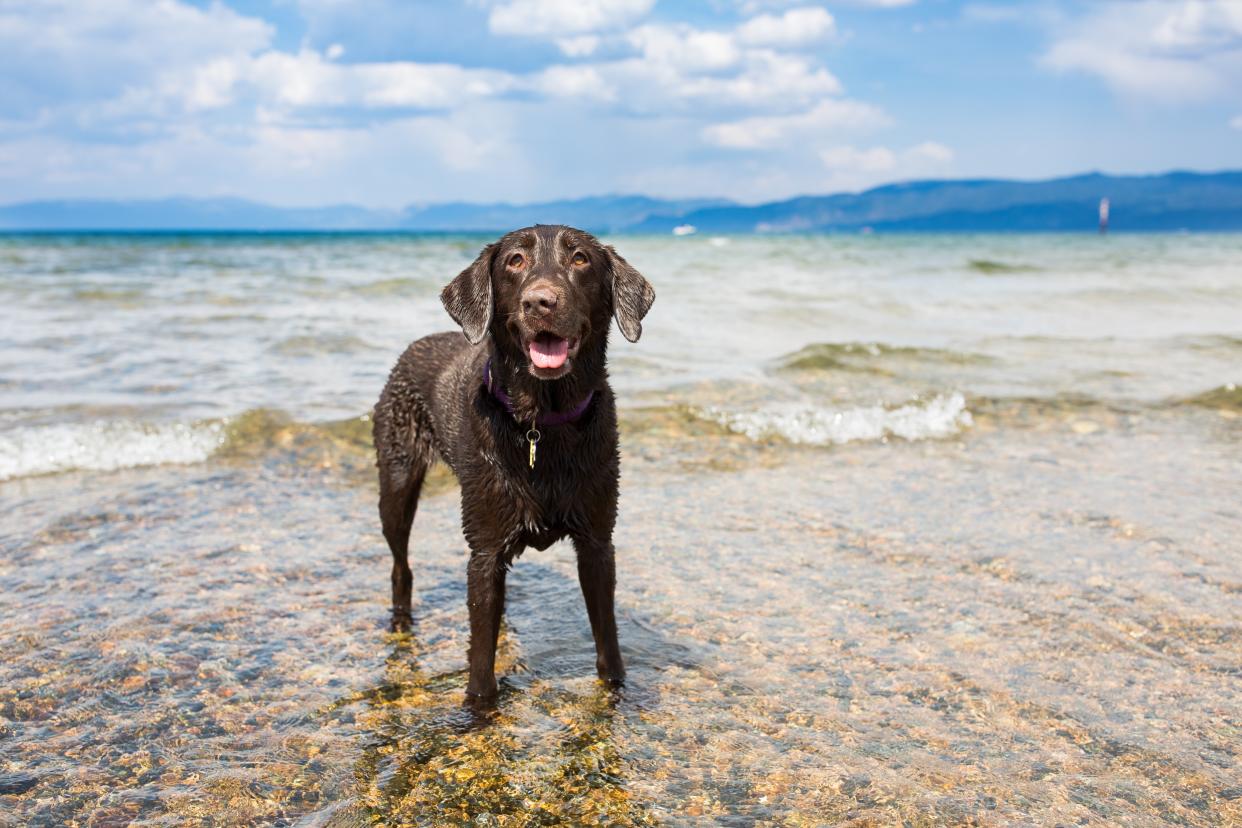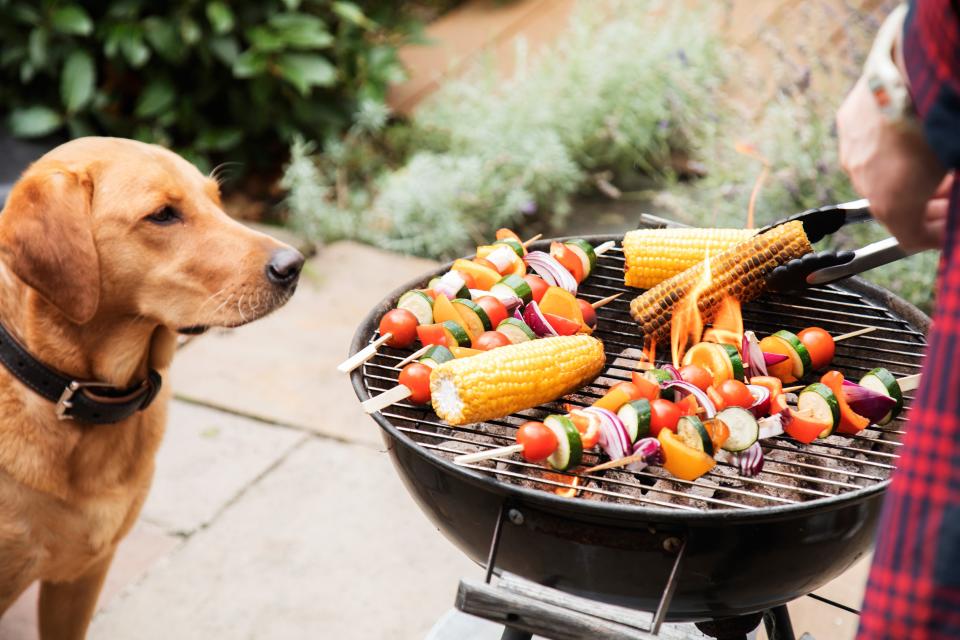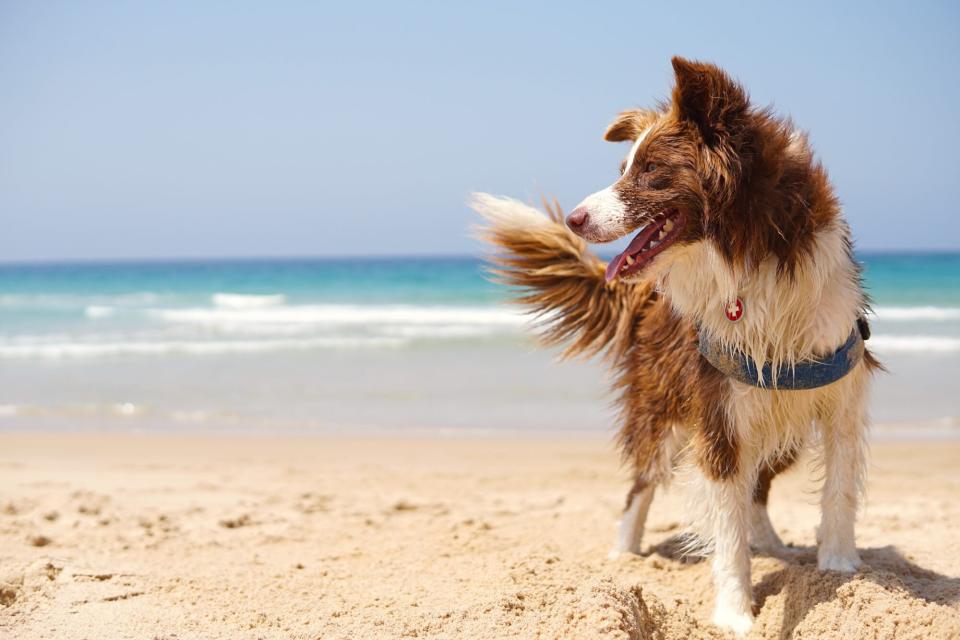How to Protect Your Pets From the 10 Most Common Summer Dangers

Getty Images
TABLE OF CONTENTS
Common Summer Threats to Pets
Heat and Humidity
Insects
Fertilizers and Pesticides
Plants
Picnics and Barbecues
The Sun
The Beach
Drowning
Pollen
Snakes
Every season poses its own unique safety risks for pets, but summer is a particularly hazardous time for your four-legged friends. From high temperatures to bugs waiting for a host to latch onto, there's plenty to keep your furry companions safe from during warmer months. Now, that doesn't mean you need to panic every time you let your pet into the great outdoors—there are a few precautions you can take to keep them safe this summer. But first, you need to know exactly what the biggest risks are to domesticated animals when the season hits. To help you with this, we turned to two experts. Here, they explain the top dangers for pets during summer and how to protect your number-one pal from them.
Related: Is It Safe to Use an Essential-Oil Diffuser Around Pets?
Heat and Humidity
Is it too hot for you? Then it's definitely too warm for your pet. For dogs, you should be especially cautious when it's hot and humid. "Humidity affects dogs differently than humans," says Dr. Lisa Bazzle, a board-certified emergency and critical care specialist and assistant professor at University of Georgia's College of Veterinary Medicine. "They aren't able to pant as effectively, which can lead to heat stroke." Signs of heat stroke—which can be fatal and requires immediate medical attention—include an increased heart rate, heavy breathing, weakness, vomiting, and diarrhea. If your pet does spend time in the yard, make sure it has access to plenty of shade and fresh, cold water.
Even if the weather is reasonably cool, it's never safe to leave your pet in a parked car; even with the windows cracked on a 70 degree day, the temperature can reach 100 degrees in less than a half-hour. On hot days, you should also be careful of your pet's feet. "Hot pavement, rocks, and patios can burn paw pads. Even artificial turf surfaces retain heat and can pose a burn threat," says Sarah Hoggan, DVM, medical director for VCA California Veterinary Specialists. Keep them protected by limiting walk and play time during peak heat hours, making sure they are properly hydrated, and providing them with a cool place to rest.
Insects
Nobody likes mosquitoes, but the notorious summertime pests are particularly dangerous to dogs and cats, who can contract heartworm from the bite of an infected insect. "Heartworm can be fatal in both dogs and cats," says Dr. Bazzle. "Mosquitoes can survive in temperatures above 50 degrees—it's one of the reasons I recommend using preventatives year round." To keep your pets safe, use a preventative that protects against fleas, ticks, and heartworm, and consult with your veterinarian to make sure the dosage is correct.
In addition to mosquitos, house flies also ramp up during summer. According to Dr. Hoggan, "houseflies can cause a severe condition called flystrike in pets with wounds or very poor grooming." She says these cases can be heartbreaking for the families and veterinary staff. To avoid flystrike, keep your pet's fur clean and mat-free and regularly check for wounds. Dr. Hoggan notes that you should also be wary of stinging bugs. "Wasps, yellow jackets, and bees can be dangerous if they attack as a swarm, or if your pet is allergic to their venom and has an anaphylactic reaction," she says.
Fertilizers and Pesticides
The chemicals that make your garden look great can make your pets sick. "Many weed killers, fertilizers, and pest-control products can be toxic," cautions Dr. Bazzle. "And unfortunately, the more toxic the chemical, the more palatable it seems to be to our pets." If you suspect your pet has ingested a fertilizer or pesticide, Dr. Bazzle recommends calling the Pet Poison Helpline or the American Society for the Prevention of Cruelty to Animals Poison Control Center. Each call center has up-to-date information on common gardening products, which tend to change formulations frequently.
As a precautionary measure, Dr. Hoggan recommends waiting until any wet lawn spray treatment is 100 percent dry and any granular lawn treatment is fully watered in and no longer visible before your animals are allowed to walk on that area of the yard. "Dogs and cats should be kept away from fertilizers because consumption can cause gastrointestinal upset with vomiting and diarrhea in mild cases, and bloody vomiting and diarrhea in more severe cases," she warns.
Related: 6 Tricks to Keep Your Pet Safe and Out of the Garden
Plants
If your pets spend time in your garden, do an audit to ensure that you're not growing any potentially dangerous plants. Before adding anything new to your garden, Dr. Hoggan recommends checking the plant's identification tag to ensure it is pet friendly. "If it doesn't state specifically, a quick Google search of the actual plant species name can help you determine if it is safe," she says. If you just moved into a home and you don't know what has already been planted, Dr. Hoggan notes that an app called Picture This has a pet toxicity section. "You simply photograph the plant, and it utilizes the image to cross reference with its database to identify the plant species and potential for toxicity," she says. According to Dr. Bazzle, plants like azaleas, rhododendrons, and tulips can cause gastrointestinal distress, while lilies, sago palm, and foxglove can be acutely poisonous. If you're concerned about your flowerbed, the ASPCA provides a list of poisonous plants.

Betsie Van Der Meer/Getty
Picnics and Barbecues
Cookout season brings about a ton of tasty treats—many of which are harmful to dogs waiting patiently under the picnic table. "Any foods that are rich or fatty are not good for pets, such as hot dogs and bacon, and the fat trimmed from steaks have the potential to cause pancreatitis," Dr. Hoggan says. "Also, an uncooked hamburger or chicken is likely to have excessive bacteria present that can cause severe illness such as salmonella poisoning."
Additionally, Dr. Bazzle warns that watermelon rinds, corn cobs, rib bones, and kabob skewers can cause intestinal blockages, while wine and chocolate can be toxic if consumed in large quantities. Another summer favorite, grapes, are extremely toxic to dogs and warrant immediate medical attention if ingested. "There's no safe amount of grapes or raisins," says Dr. Bazzle. "Even if your dog eats one, you should call your veterinarian."
Also be on the lookout for stray skewers used for grilling. Dr. Hoggan says dogs tend to swallow them whole and then come in for emergency surgery when the skewer migrates through the stomach. She also says to pour snacks into bowls rather than leaving them in bags. "Dogs will stick their head into the bag to get the chips or snacks and tragically suffocate. This is a 100 percent preventable accident," she says.
The Sun
You know it's important to wear SPF to avoid harmful UV rays, but did you know that dogs are also at risk of sunburn and skin cancer? If your dog is spending a significant amount of time in the sun or has a sparse coat, you should protect him with sunblock, says Dr. Bazzle. Just make sure you're using a product that's specially formulated for animals and is safe if ingested. Dr. Hoggan says to also make sure your pets have a cool, clean area to rest in that is fully shaded, which will "help reduce their risks of sun-related injuries or ailments."

Margarita Monge Ortega
The Beach
Come summertime, there's nothing like a trip to the beach, but make sure you have several protections in place to keep your furry friend safe if you plan to bring them along. Before tossing a toy, check that it isn't full of sand—consuming too much sand can lead to a potentially fatal bowel obstruction, warns Dr. Bazzle. Rinse toys between play sessions with fresh water, and keep an eye on your dog at all times (as unappetizing as it sounds, some simply can't resist snacking on sand). All that play likely has your four-legged pal feeling thirsty—ensure they have enough fresh water to make it through the day, so they are not tempted to drink salt water. Additionally, Dr. Hoggan says to "check for litter or debris on the beach that could cut their paws, mouths, or become a choking hazard."
Drowning
Is your dog a water bug? That's fine, so long as you keep a watchful eye on them when they're near bodies of water, whether it's an ocean, lake, or pool. "Most people just assume their dog can swim, but this isn't always the case," says Dr. Bazzle. Never coerce a hesitant dog to get in the water, and be especially cautious if your dog is on a boat or near a pool, as many dogs will panic if they fall in and suddenly find themselves in deep water. During trips to the beach, Dr. Hoggan says to stay close to your pup when they're swimming to ensure "they are not pulled out by an undertow or in case they become too exhausted to swim back to shore." If your dog isn't a strong and confident swimmer, make sure he wears a specialized life vest when near water.
Pollen
You're not the only one suffering from seasonal allergies. "Just like humans, dogs can be affected by pollen and different types of mold," says Dr. Bazzle. While airborne allergens tend to cause respiratory problems in humans, most dogs will present with itchy skin and you may also see swelling of their muzzle, eyes, and ears. Your vet may prescribe antihistamines, steroids, or allergy shots to treat the symptoms, but Dr. Bazzle also recommends keeping your home as clean and allergen-free as possible with the help of air filters and specialized cleaners. "Having a dog with allergies is almost like having a child with asthma," she says.
Snakes
Depending on where you live, Dr. Hoggan says you may run into snakes during the summer. "If you go on a hike, keep your dog close by and carry a long walking stick—you could use it to hold your dog back from a snake, or to safely scoot a snake off the trail once you have control of your dog," she says.

